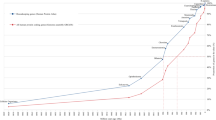Abstract
We report that the GAGE gene family of human Cancer/testis antigen (CTA) genes is likely to be in an early stage of its evolution. Members of this gene family are tandemly arranged on the X chromosome only in human, chimpanzee and macaque genomes and share a very high similarity. Phylogenetic trees show that the GAGE gene family began to duplicate after the split of human and chimpanzee. The estimated ages of the duplication events range from 4 million years ago to the present. The Ka/Ks values between the duplicates are significantly greater than 1, indicating that the mutation rate is higher in coding regions than non-coding regions of the genes, which suggests that the GAGE gene family is under positive selection. These findings indicate that the GAGE gene family may be a newly formed gene family undergoing rapid functional evolution.



Similar content being viewed by others
References
Akcakanat A, Kanda T, Tanabe T et al (2006) Heterogeneous expression of GAGE, NY-ESO-1, MAGE-A and SSX proteins in esophageal cancer: implications for immunotherapy. Int J Cancer 118(1):123–128
Brunet M, Guy F, Pilbeam D et al (2002) A new hominid from the upper miocene of Chad, Central Africa. Nature 418(6894):145–151
Chang HK, Park J, Kim W et al (2005) The expression of MAGE and GAGE genes in uterine cervical carcinoma of Korea by RT-PCR with common primers. Gynecol Oncol 97(2):342–347
Chen ME, Lin SH, Chung LW et al (1998) Isolation and characterization of PAGE-1 and GAGE-7. New genes expressed in the LNCaP prostate cancer progression model that share homology with melanoma-associated antigens. J Biol Chem 273(28):17618–17625
Cilensek ZM, Yehiely F, Kular RK et al (2002). A member of the GAGE family of tumor antigens is an anti-apoptotic gene that confers resistance to Fas/CD95/APO-1, interferon-γ, taxol and γ-irradiation. Cancer Biol Ther 1(4):380–387
de Backer O, Arden KC, Boretti M et al (1999) Characterization of the GAGE genes that are expressed in various human cancers and in normal testis. Cancer Res 59(13):3157–3165
Felsenstein J (1981) Evolutionary trees from DNA sequences: a maximum likelihood approach. J Mol Evol 17(6):368–376
Haldane JBS (1933) The part played by recurrent mutation in evolution. Am Nat 67(708):5–19
Hofmann M, Ruschenburg I (2002) mRNA detection of tumor-rejection genes BAGE, GAGE, and MAGE in peritoneal fluid from patients with ovarian carcinoma as a potential diagnostic tool. Cancer 96(3):187–193
Jukes TH, Cantor CR (1969) Evolution of protein molecules. In: Munro HN (ed) Mammalian Protein Metabolis. New York: Academic Press, pp 21–132
Kimura M (1980) A simple method for estimating evolutionary rate of base substitutions through comparative studies of nucleotide sequences. J Mol Evol 16(2):111–120
Kobayashi Y, Higashi T, Nouso K et al (2000) Expression of MAGE, GAGE and BAGE genes in human liver diseases: utility as molecular markers for Hepatocellular carcinoma. J Hepatol 32(4):612–617
Kong U, Koo J, Choi K et al (2004) The expression of GAGE gene can predict aggressive biologic behavior of intestinal type of stomach cancer. Hepatogastroenterology 51(59):1519–1523
Li WH, Wu CL, Luo CC (1985) A new method for estimating synonymous and nonsynonymous rates of nucleotide substitution considering the relative likelihood of nucleotide and codon changes. Mol Biol Evol 2(2):150–174
Long M, Betran E, Thornton K et al (2003) The origin of new genes: glimpses from the young and old. Nat Rev Gen 4(11):865–875
Nei M, Gojobori T (1986) Simple methods for estimating the numbers of synonymous and nonsynonymous nucleotide substitutions. Mol Biol Evol 3(5):418–426
Nei M, Rooney AP (2005a) Concerted and birth-and-death evolution of multigene families. Ann R Genet 39:121–152
Nei M (2005b) Selectionism and neutralism in molecular evolution. Mol Biol Evol 22(12):2318–2342
Nielsen R, Yang Z (1998) Likelihood models for detecting positively selected amino acid sites and applications to the HIV-1 envelope gene. Genetics 148(3):929–936
Prince VE, Pickett FB (2002) Splitting pairs: the diverging fates of duplicated genes. Nat Rev Gen 3(11):827–837
Sebat J, Lakshmi B, Troge J et al (2004) Large-scale copy number polymorphism in the human genome. Science 305(5683):525–528
Simpson AJ, Caballero OL, Jungbluth A et al (2005) Cancer/testis antigens, gametogenesis and cancer. Nat Cancer 5(8):615–625
Smith GP (1976) Evolution of repeated DNA sequences by unequal crossover. Science 191(4227):528–535
Acknowledgments
This work was supported by the National Sciences Foundation of China (NSFC, No. 30471906 and 30571650). We thank Fuqu Yu, Richard Callahan and Gary Potikyan for critical reading of the manuscript, and Tonghai Dou for helpful discussion.
Author information
Authors and Affiliations
Corresponding author
Additional information
Yang Liu and Qiyun Zhu contributed equally to this work.
Rights and permissions
About this article
Cite this article
Liu, Y., Zhu, Q. & Zhu, N. Recent duplication and positive selection of the GAGE gene family. Genetica 133, 31–35 (2008). https://doi.org/10.1007/s10709-007-9179-9
Received:
Accepted:
Published:
Issue Date:
DOI: https://doi.org/10.1007/s10709-007-9179-9




